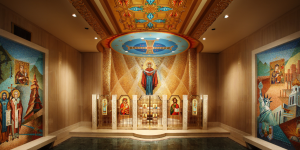

Did you know that this October 6 marks the 50th anniversary of the dedication of the Byzantine-Ruthenian Chapel? And that’s not all – it’s also the centennial of the Byzantine Ruthenian Church Exarchate in the United States, which honors the shared spiritual heritage of American and Eastern European Catholics.
A glorious sacred space where traditional iconography is surrounded in warm gold tones and regal reds and blues, this chapel is focused on the Holy Protection of the Theotokos – Mary, the Christ-bearer. As we observe this significant milestone, we invite you to learn more about how the devotion to the Theotokos originated and how the Basilica honors the Blessed Mother under this title.
History of the Devotion
The devotion to Our Lady of Pokrov originated in A.D. 626, during the siege of Constantinople. At the time of the attack, the people of the city gathered at the Church of Blachernae for shelter. There, they sang the Akathist Hymn in praise of the Virgin Mary in an all-night vigil. According to tradition, the Blessed Mother appeared and protected them under her maphorion – the Holy Veil of the Virgin – which she holds in her hands.
Today, the faithful continue to look to the Blessed Mother for protection in times of peril, inspired by the intervention at Constantinople.
The Byzantine-Ruthenian Chapel at the Basilica
 The chapel at the Basilica, which is known as the Byzantine-Ruthenian Chapel, honors the Ruthenian Catholic tradition not only in its art but also in the design of the sanctuary. Behind the altar, a mosaic of vibrant red, blue, and gold tiles depicts the Blessed Mother holding her maphorion. The iconostasis (icon screen), a distinctive feature of any Eastern Rite Church, is a wall that separates the sanctuary from the rest of the chapel and is made up of many different icons and religious symbols. The iconostasis in the Byzantine-Ruthenian Chapel features Christ the Teacher and Mary as Theotokos, while the Royal (sanctuary) doors show the four evangelists. The two Deacon (side) doors portray Saints Lawrence and Stephen, two Deacons of the early Church.
The chapel at the Basilica, which is known as the Byzantine-Ruthenian Chapel, honors the Ruthenian Catholic tradition not only in its art but also in the design of the sanctuary. Behind the altar, a mosaic of vibrant red, blue, and gold tiles depicts the Blessed Mother holding her maphorion. The iconostasis (icon screen), a distinctive feature of any Eastern Rite Church, is a wall that separates the sanctuary from the rest of the chapel and is made up of many different icons and religious symbols. The iconostasis in the Byzantine-Ruthenian Chapel features Christ the Teacher and Mary as Theotokos, while the Royal (sanctuary) doors show the four evangelists. The two Deacon (side) doors portray Saints Lawrence and Stephen, two Deacons of the early Church.
The left wall of the chapel honors the Catholic traditions of Eastern Europe, showing the Carpathian Mountains and prominent saints including Cyril, Methodius, and the weeping Madonna, Maria Pozc. The right wall represents Ruthenian Catholics in the United States, with the Statue of Liberty, the Seminary of Saints Cyril and Methodius in Pittsburgh, and an icon of Our Mother of Perpetual Help.
Join Us at the Basilica
We invite you to join us here at the Basilica as we celebrate this momentous occasion this month. On Saturday, October 12, 2024, the Byzantine Archeparchy of Pittsburgh will celebrate the 50th Anniversary of the Dedication of the Byzantine-Ruthenian Chapel at the National Shrine with a pilgrimage, including a Divine Liturgy that will be celebrated by His Eminence Archbishop William C. Skurla, D.D. of the Byzantine Catholic (Ruthenian) Metropolitan Church.
Source:
Rohling, Geraldine M., PhD, MAEd. The Basilica of the National Shrine of the Immaculate Conception: Guide and Tour Book. Washington, D.C.: Basilica of the National Shrine of the Immaculate Conception, 2018.
Light a Candle at the Basilica
 In honor of Our Lady of Pokrov, we invite you to light a candle today at the National Shrine. Vigil candles burn in the chapels throughout the Great Upper Church and lower crypt level of the National Shrine. Each candle represents the faith of the supplicants and their fervent prayers entrusted to the loving intercession of the Blessed Mother.
In honor of Our Lady of Pokrov, we invite you to light a candle today at the National Shrine. Vigil candles burn in the chapels throughout the Great Upper Church and lower crypt level of the National Shrine. Each candle represents the faith of the supplicants and their fervent prayers entrusted to the loving intercession of the Blessed Mother.

